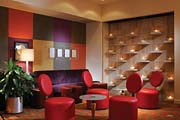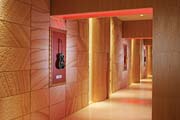
Hard Rock Cafe International is on a roll, as it staged yet another grand opening in Tampa, FL, last Spring. As a result of a licensing agreement made with the Seminole Indian Tribe of Florida and the Cordish Co., the Seminole Indian reservation in Tampa was signed over to Hard Rock Cafe, where a $400 million hotel and casino resort has been built. The use of Australian sandstone has coincidentally integrated symbolic natural elements of the Seminole Tribe, and has solidified the overall design with a remnant of tribal beauty.
In a serendipitous tribute to the legacy of the Seminole Tribe, over 3,500 square feet of Australian sandstone, quarried and fabricated by Gosford Quarries, was used to stylize the lounge area and panel walls within the resort. Natural sandstone has a history with the Seminole Indians, as the deserts in Colorado -- the birthplace of the Seminole Tribe -- are home to one of the largest sandstone landscapes.
Perhaps the most dramatic use of sandstone at the Tampa Hard Rock location is the “firewalls†within the lounge. This unique space called for a unique design, and designer Larry Lee of Laurence Lee Associates took his inspiration from the “Rum Jungle†bar and restaurant at the Mandalay Bay Casino in Las Vegas. “We wanted movement,†said Lee. “I felt that water has been overdone and can seem redundant, and what is the direct opposite of that…fire. It was a just a question of how to use it, and then I thought of the Rum Jungle.â€
There are two separate firewalls, and each is composed of 24 Australian sandstone shelves on each of which a bowl of flames seemingly free stands. However, the bowls and the flames are more complex than they seem. “Intricate gas lines and burners, similar to the ones you may find in a stove or grill, had to be built into every shelf, by a fire and water consultant and a crew of craftsmen,†said Lee. “Behind the wall is the main pipe system and the tank, which can be turned off and on with a switch behind the bar.â€
The Hard Rock's panel walls that dress the path to the conference rooms of the resort are also clad with the sandstone slabs. Using a rougher finish, these pieces add texture that appears soft to the eye. The glow of the sandstone is heightened by the strategic placement of track lighting and music memorabilia that provide a warm inviting feeling, and a textured finish was specified for the stone used in the corridors. “The texture specified is a 'punch finish' created by our stonemasons using a chisel called a punch and hand working over the surface of the stone,†said Gary Hargreaves of Gosford Quarries.

Sourcing the stone
Laurence Lee's decision to use Australian sandstone for the Florida casino actually developed near his office in California. “I set up different locations to display the [Australian sandstone] in Southern California,†said Robert Barnes of Keystone in Santa Monica, CA, the stone supplier and representative for Gosford Quarries. “Laurence Lee's wife saw the stone in one of the displays at a design showroom in Santa Monica. I took samples to Laurence Lee and after a process of shipping samples to Florida and California, it was eventually approved and they then handed it off to Perini, the General Contractor of the project, who did the purchasing of the materials.â€Despite the unique nature of the design, no mock-up was required. “We were able to [convey the look of the stonework] by working with the samples. We also gave them ideas with other projects done in Australia, and they looked at that.â€
“The sandstone is from our Mt. White quarry near the City of Gosford, approximately 1 1â„2 hours drive north of Sydney,†explained Hargreaves. “This stone is usually quarried a light brown with attractive irregular brown banding, but also can be found in a white range. The sandstones from the Gosford region are quite unique because of these decorative patterns and because the stone can be quarried in large blocks with very consistent quality. We have been exporting this type of sandstone for many years, and it is extensively used in Germany, Japan, China, Indonesia, and more recently we are supplying claddings in Kuwait."

Installation challenges
Given the unique nature of the firewalls, installing the stonework was a challenge for Greer Tile, the stone installation subcontractor. “We had to conceal the burners inside the stone, and that was all core drilled,†said Todd Goosen, project manager for Greer Tile. “It actually made the installation more difficult because we had to work along with the crews doing the gas piping. We preassembled the burners in the stone, and then everything was installed.†Each of the two firewalls, which can be found on opposite ends of the lounge, measure roughly 10 x 8 feet in size.The stone was installed using metal clips and 3â„4-inch stainless steel pins. The shelves were mounted on the pins, which were then bolted to the framing. Meanwhile, the wall itself was covered with Durock, and the vertical stone panels were adhered to the Durock with Mapei thinset.
Overall, Goosen said that setting the sandstone shelves was the most difficult aspect of the project. The shelves were mounted on the pins, which were then bolted to the framing. “We had to fabricate the stone to encompass the pins and the burners. If the pins were out of level, then the shelf would be out of level. The stone is epoxied to the stainless steel pins, so once we had the stone in position, we would have to keep it in position until the epoxy set.â€
Greer Tile was responsible for installing all of the stone and tile work in the casino and hotel guest rooms, and they had 35 people on the job at its peak, including helpers and mechanics. Goosen was very involved in the work on the firewalls, and he worked with two other crew members on that aspect of the project. “That was near the end of the project, and so there was a tremendous time push on this.â€
In fact, to meet the casino's opening date, the sandstone was actually flown in from Australia. “We had the material ready at a port in Sydney, and it ended up on a plane. It seemed costly, but it was explained to me that the cost of keeping a casino closed would have been much more than the cost of flying the stone in,†Barnes said. “[Gosford] packed the stone carefully with special packaging, and there was no problem with breakage.â€
The opening of the new Hard Rock Cafe in Tampa is another bold step for the organization, which also opened a hotel/casino on the opposite end of the state in Hollywood, FL. Since opening its doors to the public, the casino has been met with favorable reviews, and according to the architect, the stonework played a major role in the project's success. “The single most outstanding element was the sandstone,†Lee said. “It has the most dynamic texture, the most dynamic style, and it is the major material that stands out.â€
End box:
Hard Rock Hotel and Casino, Tampa, FL
Architect: Laurence Lee Associates, Los Angeles, CAStone Quarrier/Fabricator: Gosford Quarries, Annandale, NSW, Australia
Stone Supplier: Keystone, Santa Monica, CA
Stone Subcontractor: Greer Tile, Delray Beach, FL
General Contractor: Perini Building Co., Inc.